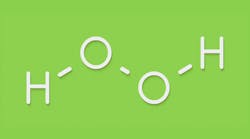Hydrogen peroxide and patient care during the COVID-19 pandemic: Roundtable recap
On August 26, 2020, RDH magazine and Perio Protect partnered to provide the first of the COVID-19 roundtable discussions. (You can watch the roundtable on demand here.) The discussions are designed to highlight the latest industry technologies that can increase clinician safety, review the benefits of Perio Protect technology, and discuss time management strategies for our new normal of dental hygiene. This webinar featured industry experts Nicole Fortune, RDH, and Katrina Sanders, MEd, RDH, who both practice clinically. The panel discussion questions have been included below with the answers that were provided.
Oxygen’s role in healing
Oxygen plays a vital role in wound healing. Oxygen is needed for cell function to kill bacteria and to stimulate new blood vessels. Red blood cells carry oxygen throughout the body, and if circulation is poor, the body will not have adequate red blood cells to carry oxygen to the area of healing. Patients who demonstrate a lack of oxygen show greater complications after surgery or trauma. A study conducted by Haley et al. found that wound infections were significantly lower in patients with more oxygen. Topically applied oxygen demonstrated improved wound healing and faster healing times.1
When it comes to oral health, patients who are mouth breathers, smokers, or have medication-induced xerostomia have decreased oxygen levels.1 The dark, moist environment of the oral cavity allows anaerobic bacteria to thrive and multiply quickly. Introducing oxygen via stimulation of interdental aids, toothbrush bristles, water flossers, and other oral health devices removes biofilm and promotes healing through increased blood flow.1
How does improving patient home care before their visit reduce the potential transmission of the COVID-19 virus?
Dental hygienists and dentists are two of the highest occupational risks for contracting the COVID-19 virus. This is due to the aerosolization of bacteria from the procedures we provide. Any bacteria that is in the mouth has the potential to become aerosolized through coughing, speaking loudly, or through the procedures that dental hygienists provide while the patient is chairside. Patients with meticulous home care have fewer bacteria to become aerosolized. When patients arrive for dental care, a preprocedural rinse should be implemented to reduce the bacteria before treatment.
Clinical studies confirm that oxidative antimicrobial rinses have abilities to reduce viral loads in the oral cavity while eliminating bacteria, fungi, and other microorganisms. Hydrogen peroxide is a recognized antimicrobial against SARS-CoV and is recommended in pretreatment to reduce the risk of oral transmission of SARS-CoV-2 via saliva.2 The American Dental Association recommends a preprocedural rinse antiseptic and oxidizer, hydrogen peroxide. Hydrogen peroxide is typically sold in a 2-3% solution and should be diluted to 1-1.5% and administered to patients to gargle for 60 seconds.2
What is the active ingredient in the gel that is placed in the Perio Protect trays?
Hydrogen peroxide may seem like the dental industry’s new trend; however, the antimicrobial has been recognized for its ability to reduce gingival inflammation for years. The active ingredient in the gel that is placed into the Perio Protect Trays is 1.7% hydrogen peroxide.
How are Perio Protect Trays implemented at home?
When a patient is diagnosed with gingival inflammation or periodontitis, the Perio Protect technology can serve as an adjunctive therapy. The customized trays are designed with a patented seal to place and hold medication at the site of an infection deep below the gum line. The trays are designed for pocket depths up to 8 mm.
The patient places a thin layer of the prescribed Perio Gel across the gum indentations. The gel can be distributed by using a Q-tip or the small brush that is included in the kit. The patient then places the tray into the mouth and ensures that the tray covers all of the teeth and sits fully in place. Any excess gel can be expectorated by the patient into the sink. The trays should fit snugly to the tooth and be worn at least once per day for 15 to 20 minutes. For more advanced cases, the trays can be worn multiple times throughout the day but should not be worn overnight. Once the allotted time is completed, the patient should remove the trays and brush their teeth normally. If there is any additional gel left behind, the patient should rinse with water. The Perio Protect Trays should be rinsed with water, towel dried, and placed in the container provided in the Perio Protect kit. Hot water should be avoided to prevent alteration of the product. Soaking the product in anything other than warm water is contraindicated, as discoloration can occur. The trays are not a substitute for daily biofilm removal, and patients should be encouraged to obtain meticulous home care to prevent progression of oral diseases.
What have the clinical studies demonstrated from patients who have implemented Perio Protect Trays?
When compared with scaling and root planing (SRP) alone, clinical improvements in periodontal probing depth (PPD) were maintained for up to six months after SRP with adjunctive use of 1.7% hydrogen peroxide gel delivered through the Perio Protect Trays.4
Clinical studies demonstrated that subjects with moderate to advanced periodontitis who implemented the Perio Protect Trays showed significant clinical improvements in pocket depths and in bleeding compared to scaling and root planing alone.5
Hydrogen peroxide has been safely delivered in trays for more than 10 years to treat periodontal disease. The oral debridement agent is an effective antimicrobial for chronic oral wounds inducing periodontal disease. The Perio Protect Trays can deliver the gel subgingivally for depths up to 9 mm.6
Perio Protect Trays are a minimally invasive treatment that can be implemented in patients with severe gingivitis to severe periodontitis. The trays do not replace the mechanical removal of biofilm; they serve as an additional therapeutic aid for patients. This technology can serve as adjunctive therapy for patients who want to postpone their routine hygiene visits due to their compromised systemic health.
References
1. Greif R, Akça O, Horn E-P, et al. Supplemental perioperative oxygen to reduce the incidence of surgical-wound infection. New Engl J Med. 2000;342:161-167. doi:10.1056/NEJM200001203420303
2. Ortega KL, de Oliveira Rech B, Ferreira Costa AL, et al. Is 0.5% hydrogen peroxide effective against SARS‐CoV‐2? Oral Dis. 2020 June 21;10.1111/odi.13503. doi:10.1111/odi.13503
3. Matthews CO. The benefits of preoperational oral rinsing during and after the novel coronavirus pandemic. National Dental Association white paper. April 2020.
4. Putt M, Proskin H. Custom tray application of peroxide gel as an adjunct to scaling and root planing in the treatment of periodontitis: results of a randomized, controlled trial after six months. J Clin Dent. 2013;24:100-107.
5. Dunlap T. Prescribing hydrogen peroxide in the treatment of periodontal disease. Oral Health. 2016;Dec:64-68.
6. Dunlap T, Keller DC, Marshall MV, et al. Subgingival delivery of oral debriding agents: a proof of concept. J Clin Dent. 2011;22(5):149-158.
Amber Auger, MPH, RDH, is a practicing dental hygienist and clinical innovations implementation specialist. With 14 years of experience in the dental industry, Auger works with practices to provide customized protocols, to refocus on the patient experience, and to utilize systemic approaches to periodontal therapy. She is a regular contributor to RDH magazine, a featured author for DentistryIQ, and host of #AskAmberRDH. Auger also provides preventive services abroad yearly and is always willing to have dental professionals join her team. She can be reached at [email protected].







